Archive for the ‘Jeff Burton’ tag
ShoppinPal.com smart phone app from Fermyon, Inc. improves the brick and mortar retail shopping experience for both buyers and sellers
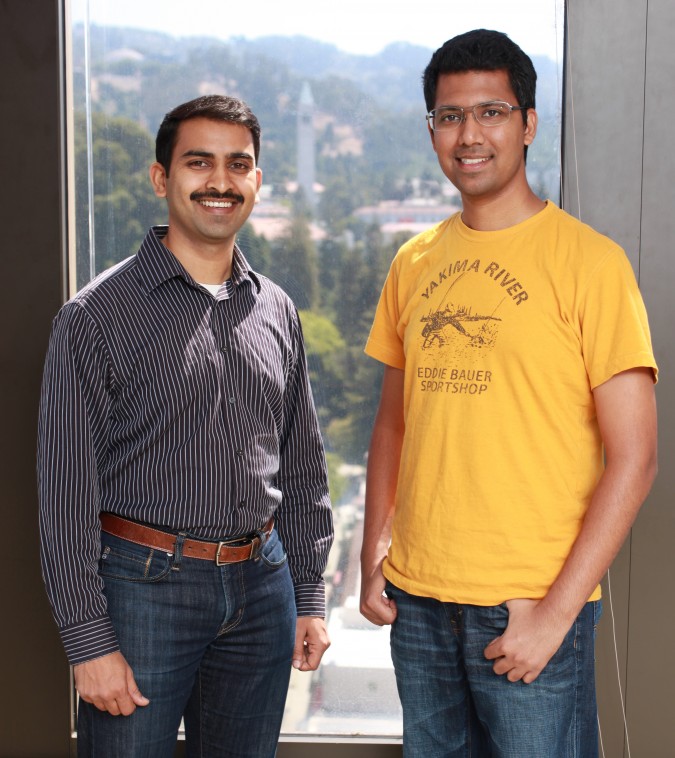
Cofounders of ShoppinPal.com - Sriram Subramanian, CEO, and Pulkit Singhal, CTO. July 26, 2013. Photograph taken at University of California Berkeley Skydeck accelerator, on the top floor of the tallest building in Berkeley, California. That clock tower in the background is on the UC Berkeley campus. Photo by Kevin Warnock.
Fermyon, Inc. is the company behind the impressive ShoppinPal smart phone application that improves the retail brick and mortar retail shopping experience for both buyers and sellers.
On Friday, July 26, 2013, I met with Sriram Subramanian, Chief Executive Officer, 34, and Pulkit Singhal, Chief Technical Officer, 29, the co-founders of Fermyon.
Retailers complain about people treating their physical stores as free showrooms for consumers to touch and evaluate items they will then actually buy online, frequently from giant Amazon. The retailer I suspect feels cheated by these people since they received something valuable, but didn’t make a purchase from the store to compensate the store for their efforts.
Consumers like mobile shopping apps like the one Amazon gives its customers. Smart phone shopping apps let people look up specifications and customer reviews to help them make smarter purchasing decisions. I don’t see shopping apps disappearing, since they offer such compelling value to consumers.
Retailers with physical stores could of course create their own smart phone applications that mimic those from huge online merchants, but it’s mostly larger chain stores that do, because writing a shopping application is difficult and costly.
That’s where ShoppinPal comes in.
ShoppinPal is a service that retailers pay money for — 3% of sales for retailers with over USD $5,000 in monthly ShoppinPal sales, or $49.00 + 3% of sales for retailers that sell less than $5,000 a month through ShoppinPal. This strikes me as assertive pricing, but if it works, Fermyon will be in a position arguably even better than Visa and Mastercard, because Fermyon is not taking any fraud or refusal to pay risk that I can see. On the other hand, no small retailer could hope to deploy a system like ShoppinPal by developing the system itself, and showrooming is a looming problem that likely is motivating retailers to take defensive action.
Shoppers use the service for free.
The retailer gets access to a custom branded application its customers can install on their own phones. In addition, the retailer gets access to an online management console that shows what customers are buying, among many other statistics. Since buyers provide their email address when they install the smart phone app, the store can easily send them custom messages.
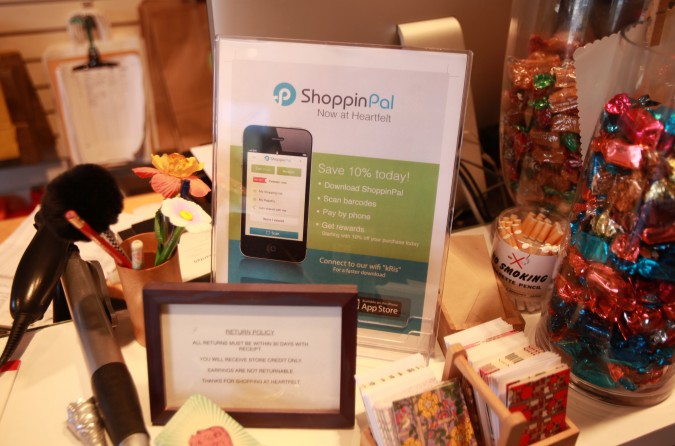
ShoppinPal app display at Heartfelt gift store at 436 Cortland Avenue, San Francisco, California, USA, August 1, 2013. Photo by Kevin Warnock.
For example, if a potential buyer uses the smart phone app to add several items to their ‘wish list’ the store will know about that and can gently remind the potential buyer to return to the store to buy the items. Buyers can be especially enticed to return by being sent discount codes that buyers can use to receive the items at a lower price. Buyers can even opt to have the items delivered to them, offering the convenience of online shopping to the offline world.
I like ShoppinPal. The small team of two co-founders and three staff have put together an offering that appears to come from a larger entity that has raised far more than the modest USD $120,000 in outside capital that Fermyon has taken in.
Buyer engagement potentially starts moments after walking through the door of a shop. One can ‘check in’ to the ShoppinPal app, like one ‘checks in’ on Facebook. The check in alerts store management that the buyer was present.
Next the customer can use the camera on their smart phone to scan the bar code on items they are interested in. The app recognizes the bar code and pulls up that product. The app can, at the option of the retailer, show customers recommendations for other items they may like in their store.
For new retailers, the ShoppinPal cloud based software taps into the retailers’ point of sale cash register system and reviews the receipts for the prior six months of sales. The software sees that people purchased certain items during the same transaction, and uses that set data to recommend that future purchasers also consider such grouped purchases.
CTO Singhal asked current retailers using their system to try the recommendation engine, and those queried marveled at how the recommendations matched with their memory of what many past customers had bought together.
The ShoppinPal app and the website are both beautiful – spare, elegant and clean. The management console is by Mixpanel, a separate company ShoppinPal pays to provide that service.
Sellers can add various incentives for shoppers to buy more items. For example, a discount can be applied after a certain number of purchases. Thus, a coffee shop could automate the ‘buy 10, get 1 free’ paper punch card that still is in use, and was in use at the tea shop where I met with Singhal and Subramanian.
That tea shop in fact allowed customers to store their paper cards in a physical file system on the counter out for the public to access. I marveled the tea shop would put such sensitive information out on public display, because a competitor could surreptitiously copy down a list of the shop’s best and most loyal customers. With quality video cameras in every smart phone, someone could just pretend they were looking for their card while capturing video of every card the thief perused. An electronic loyalty system like that included in ShoppinPal reduces the risk a customer list can fall into the hands of an outsider or an employee that should not have that information.
Inside ShoppinPal, there is not only a wish list, but a gift registry, which should encourage others to buy at a retailer the others may not even be aware of when the items are added to the registry.
ShoppinPal communicates via application programming interfaces to two point of sale cash register systems — Lightspeed Retail and Vend. ShoppinPal hands off to the cash register the precision task of calculating sales tax, sidestepping a thorny problem, since there are thousands of sales tax jurisdictions.
As a customer walks around a store, as they pick up items and place them in their physical shopping cart or basket, they can click ‘add to cart’ within the mobile app. This gives a running total of their planned purchases, and when the customer is ready to pay, they can buy directly from the app, which will display a receipt on screen the customer can show to store staff as they pass through the exit.
This pay within the app feature over time will let retailers hire fewer checkout clerks. The pay within the app feature can be turned off by the retailer that prefers customers visit a cash register to physically run their credit cards through a credit card terminal.
Whether the purchase is paid for in app or at a retailer’s register, the ShoppinPal management console keeps track of all the buyers’ purchases, and makes the purchase history available to the customer, which in my mind is a great perk for the customer. When I shop at Lowes and HomeDepot, I use their loyalty cards mostly because their systems email me a copy of my receipt within minutes after a purchase, which makes my life easier at income tax time.
The sexiest feature of the mobile app is a feature that adds fun to getting a discount. Instead of just writing out ‘you get a discount’ the app presents a silvery gray patch that looks just like the silvery patches covering the digits on lottery tickets. You have to ‘scratch off’ the patch with your finger, and as you rub the screen with your finger, the silvery ‘material’ under your finger vanishes. The effect was startlingly captivating such that I believe a tiny company could be formed just to advance this feature inside other unrelated products from other companies.
ShoppinPal is still an early stage venture. The company was incorporated in January, 2011, but work didn’t really accelerate until CEO Subramanian completed his MBA in June, 2012, last year.
Fermyon has signed up four customers, all via resellers that have agreed to carry their product. I view it as a positive sign that resellers are promoting their product while the company is still so young, for resellers have to be particularly careful to not damage their reputations.
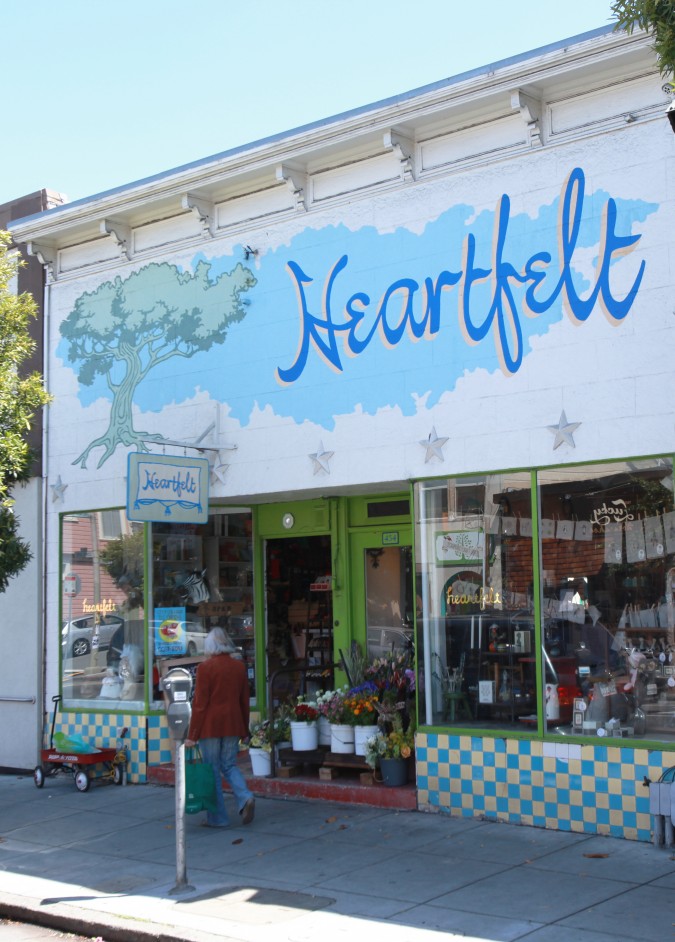
Exterior of Heartfelt gift store at 436 Cortland Avenue, San Francisco, California, USA, August 1, 2013. Photo by Kevin Warnock.
ShoppinPal’s customers are Harney & Sons in New York City, Heartfelt in San Francisco, Isha USA in Tennessee and Marthas Vineyard Glassworks in Massachussets, all in the United States. The Isha implementation is the most demanding, because the organization runs events that draw about 1,000 people twenty times or so per year, so the transaction volumes spike tremendously during events and subside the rest of the year.

Interior of Heartfelt gift store at 436 Cortland Avenue, San Francisco, California, USA, August 1, 2013. Photo by Kevin Warnock.
I live in San Francisco, so I decided to install the ShoppinPal app on my Apple iPhone 5 and visit Fermyon’s customer Heartfelt, a charming and totally adorable gift shop in the Bernal Heights neighborhood. This single store business doesn’t sell items that people are likely to evaluate and then order online from a giant website. But the Heartfelt is the kind of place that I think could benefit from the loyalty, gift registry and wish list features in ShoppinPal. The store also I suspect prides itself on having just the right gift, as there appear to be over 10,000 different items for sale inside this small store. As I was browsing around, I found half a dozen items I wanted to buy, and I am not even looking for gifts right now.

Jewelry for sale at Heartfelt gift store at 436 Cortland Avenue, San Francisco, California, USA, August 1, 2013. Photo by Kevin Warnock.
As soon as you check in, a horizontal red line starts sweeping up and down the phone display. The indicates the phone is looking for a bar code to recognize. I created a video of the ShoppinPal experience from checking in to just before payment. I have embedded the video into this post. The video is a bit shaky because I had to hold my large camera in one hand, and operate the app with my other hand, and since the phone was so close, the depth of field was shallow. But the video does show faithfully what the app does.
As soon as the app finds a bar code, it goes into search mode where it’s communicating with the cash register computer to find the item. This takes about two to six seconds. Then the item shows up in your shopping cart. From there it is confusing what to do next, since there is no ‘checkout’ or ‘buy now’ button. Instead, to continue shopping, you are to press the button in the upper left labeled ‘heartfelt,’ the name of the store. This should be labeled ‘back’ or ‘continue shopping.’ There is a button in the upper right called ‘cart.’ I didn’t try that button, but I assume that button takes you to the shopping cart from where one can checkout.

Textiles for sale at Heartfelt gift store at 436 Cortland Avenue, San Francisco, California, USA, August 1, 2013. Photo by Kevin Warnock.
I scratched off the panel as invited, and I got a 10% discount. I was given the chance to pay via credit card or PayPal, the payment service from auction giant EBay. I bought a lightweight wallet made from Tyvek, and I paid via PayPal. The process was quick and efficient, but my receipt listed my discount as $0.00 even though the 10% discount had been correctly applied to the total. I understand that ShoppinPal was only recently installed at Heartfelt, so I expect there to be small glitches to be worked out. For such an early stage yet ambitious application, ShoppinPal performed well.
As you might imagine, ShoppinPal has big dreams and has had sales meetings with huge brands that are household names throughout the US. I suspect that after they build their credibility with smaller retailers for the following months that they will land a national retailer.
ShoppinPal participated in 2012 in the Silicon Valley Bank Seed Showcase, a pitch event to investors for Silicon Valley Bank clients. Silicon Valley Bank is widely considered one of the most important banks in Silicon Valley for startups that aspire to or have raised venture capital investment. You can watch CEO Subramanian pitch on stage and then watch him later that day be interviewed by Carrie Walsh, Managing Director II, ESG, Silicon Valley Bank.
I could find no direct competitors to Fermyon.
The closest offering appears to be CardFree, which automates via a smart phone app some of the tasks that ShoppinPal automates, like payment and loyalty. But CardFree omits the ability to scan the barcode of products to bring up specifications and Amazon.com like product recommendations, two of the most compelling features of ShoppinPal, in my mind.
Another company that does part of what ShoppinPal does is CardStar from Constant Contact. CardStar appears to be a smart phone app just for storing and using loyalty cards from multiple retailers, so your physical wallet doesn’t burst from storing too many physical cards, like mine is threatening to do.
Another loyalty card company is BellyCard, which appears to be similar to CardStar.
Finally, there is a smart phone payment app called AisleBuyer, which lets in store purchasers pay via their smart phone. This company was acquired by Intuit in 2012.
See what former CNET Editor at Large Rafe Neeleman had to say about ShoppinPal in 2012.
The company’s name Fermyon is a play on the particle physics term Fermion. The definition of the Fermion is better left to the article on Wikipedia I just referenced.
I took the picture of Subramanian and Singhal that accompanies this post with my Canon 5D Mark II camera, my Canon 50mm f:2.5 macro lens and my Paul C. Buff Einstein studio flash unit.
The location of the photograph is the Skydeck accelerator run by University of California Berkeley. Jeff Burton is the Executive Director of Skydeck, and Burton encourages me to write about the UC Berkeley affiliated companies that the accelerator houses in its exceptionally glorious 10,000+ square feet of penthouse office space. If you look out the window in the center of the picture, you will see the clock tower that serves as the focal point of the UC Berkeley campus. ShoppinPal is headquartered at Skydeck, but this is not an indicator that the team is reckless with its finances. To the contrary, it’s an indicator that the team is careful with its money since the company’s office space is provided for free by the University of California, from where Subramanian earned his Masters of Business Administration graduate degree. Skydeck gives free office space to only the companies it deems most likely to succeed.
I became aware of Subramanian over the last year because we both attend monthly Cal Founders meetings, which are designed to help founders and mentors be more successful in business. Subramanian and I are more acquaintances than friends since we’ve only met and spoken a handful of times. He learned of this blog and asked if I would write about his venture, and I agreed because I had become intrigued when he had introduced his company during the roundtable discussions at Cal Founders meetings. I disclose the circumstances of how we met to deflect any appearance of bias due to my already knowing Subramanian.
Berkeley Entrepreneurs Forum, 2012-13 Angel & Venture Capital Financing Overview – August 30, 2012

The Berkeley Entrepreneurs Forum, August 30, 2012, held at Stanley Hall, room 105, because Anderson Auditorium was booked
On August 30, 2012 I attended the 2012-13 Angel & Venture Capital Financing Overview at The Berkeley Entrepreneurs Forum.
The August 30th Forum was the first of this academic year. The Berkeley Entrepreneurs Forum is a production of The Lester Center for Entrepreneurship & Innovation at the Haas School of Business at the University of California Berkeley.
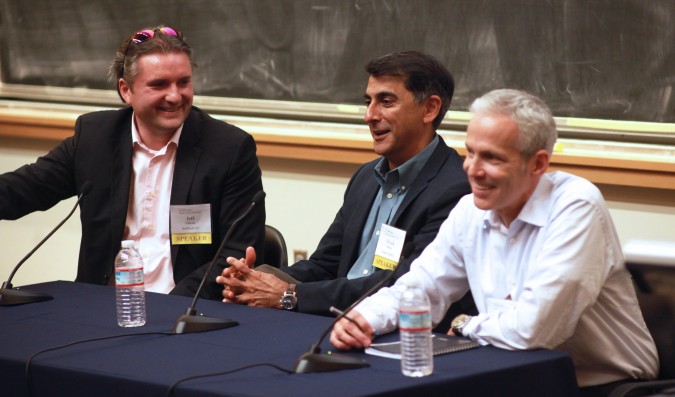
Panelists Jeff Clavier, Vivek Mehra and Jim Barnett at Berkeley Entrepreneurs Forum, August 30, 2012. Photo by Kevin Warnock.
The first Forum of the year for years now starts with Steve Bengston’s presentation of the Shaking the Money Tree report. I suspect Bengston has made this presentation hundreds of times, as he gives it not just at the Forum, but at many venues. In fact, I suspect it’s Bengston’s signature talk.
You can watch the full video of the Forum here to see what happened. I am a photographer, not a videographer. This is not the official video, which The Lester Center will publish in its entirety some weeks from now, I believe. I suggest you watch that version, because it will have professional sound from a mixing board, the slides will likely be full screen so you can read them, and the camera used is far better than the still camera I used that happens to also shoot video. I did not upload this video at full quality, since such video takes far longer to compress for Internet display.
There were some good lines from the speakers. I’ve transcribed my favorites here:
Steve Bengston:
“It [venture capital] finally got big in the mid to late 90s and now we worry when the venture business goes from $30B to $20B, but it never got above $20B until 1998 so the scale of the venture business is just much bigger than it’s ever been.”
“What about Series A, ‘didn’t that collapse?’ It is down certainly from the peak but you can see whatever that is there are $200M to $400M of series A deals each quarter just in Silicon Valley and that represents about 50 to about a 100 Series A deals in Silicon Valley each quarter.”
“The good news is there is a lot of money for your deal if you meet the certain metrics for an investor.”
“If you’re going to raise money which is still hard to do, you’re going to raise around $3M. That’s a typical deal. In this era, that buys you a lot more months of burn than it would have say ten years ago.”
“You have 300 to 400 M & A exits in the US a year in the US, much higher than the old days.”
“The top five or so [venture] firms are raising 80% of the money.”
“It begs the question ‘How many VCs do you need to find the 30 good companies every year?’ Right now the answer is about 3,000. For many people that seems high.”
“China has been the number one economy 15 of the last 18 centuries. So, just because they have had a couple of bad centuries you don’t want to count them out. They are used to being on top.”
Jeff Clavier:
“The challenge at the early stage is that even great founders can come up with really stupid ideas.”
“Do it because you are passionate about it, not because it’s cool.”
“I passed on airbnb that some showed me when it was called air bed and breakfast and I said ‘air bed and breakfast… are you f—ing kidding me?'”
Jim Barnett:
“One of the danger signs that all the partners look for is what we call ‘complexifiers’ — people that take what is otherwise a relatively simple business proposition or business idea and figure out how to make it complex.”
“The one thing I would say to those thinking about starting a company or planning to start a company is just go do it. Your idea really doesn’t need to be that great. It really doesn’t. If you’re great, it will get funded.”
“I want to dispell a myth that you learn more from your mistakes than you do from your successes. I think that is just a bunch of crap. I really do. I think you learn from watching success — pattern matching, whether it’s in sports whether it’s in business or anything else so for those of you that are in the audience that are MBAs or that are undergrads that are thinking about what do if they’re not going to start a company I would say ‘go work for a successful company and watch.’ You’ll learn a lot more than doing three failed startups.”
Vivek Mehra:
“I hate doing deals over the weekend. I have never done one and I hope I never have to do one. It’s just impossible to get to know the entrepreneur.”
“When there are very asymmetric equity assignments amongst the team you know what they really think about each other.”
Here is my succinct summary of this Entrepreneurs Forum:
- The venture industry is in trouble, but there is still plenty of money around.
- Lots of angel investors are making what will prove to be poor investments so this increases the chances that you can raise money even if you or your idea are not that good.
- There is a lot to be gained by just starting a company, so if you are passionate about doing so, then go for it. You won’t ruin your chances for future success by failing a few times.
- However, if you’re not going to start a company, you should work for a clearly successful company so you can pay attention and learn from the success of others.
- Surround yourself with high quality people.
- Don’t make things more complicated than they need to be.
- Have your role worked out with your founders before you pitch to investors. Lopsided equity divisions speak loudly to investors what you think of your co-founders.
- Increase your chances of getting funded by persistently pursuing entrepreneurship over years, so investors may gauge your actions over your words.
- Work hard and recognize that a lot of success may be attributed to your ability to forge healthy and respectful long term relationships with people in the community.

Panelist Jeff Clavier answers questions at the Berkeley Entrepreneurs Forum, August 30, 2012. Photo by Kevin Warnock.
From the Berkeley Entrepreneurs Forum website, here are the introductions for the moderator and speakers — I added the hyperlinks to make it easier for you to learn more about the panelists and their many interests:
Samuel B. Angus
Partner
Fenwick & West LLP
Samuel B. Angus is a partner in the Corporate and Venture Capital Group of Fenwick & West LLP, a law firm specializing in technology and life sciences matters. Mr. Angus is resident in the San Francisco office and his practice concentrates on advising start-up/venture-backed companies, venture capital and debt financings, mergers and acquisitions, intellectual property licensing, joint ventures and general corporate matters. Mr. Angus represents a broad range of companies from privately held start-up companies to publicly traded corporations, including Airbnb, Github, Marin Software and oDesk. His practice also includes advising entrepreneurs and investors.
Jim Barnett
Partner
Shasta Ventures
Jim Barnett is a Partner at Shasta Ventures and has been a highly successful serial CEO and entrepreneur. Jim is currently chairman and co-founder of Turn, chairman of Extole and Sojern, and a board member of Needle and RelayRides. From 2004 until 2009, Jim was CEO, chairman and co-founder of Turn, the leading platform for managing data driven digital advertising. Before that he was president of Overture Search, a division of Overture Services, Inc. Jim joined Overture via its acquisition of AltaVista Company, where he was president and CEO. In this role, he led the company’s successful turnaround and sale to Overture.
Jim was also president of Ancestry.com (MyFamily.com) and president and CEO of ThirdAge Media, which was acquired by Ancestry.com. Prior to that, Jim was president and CEO of Infogrammes North America, a leading global publisher of video games and entertainment software. He was also chairman, president and CEO of Accolade Inc, Infogrammes’ predecessor company, and prior to that was chief operating officer of an “Inc. 100 Fastest Growing Private Companies.”
Jim has served on the boards of many private and public companies including SideStep, Inc. where he was chairman and Petco where he was also an early investor. Jim earned a bachelor’s degree, MBA and J.D. from Stanford University.
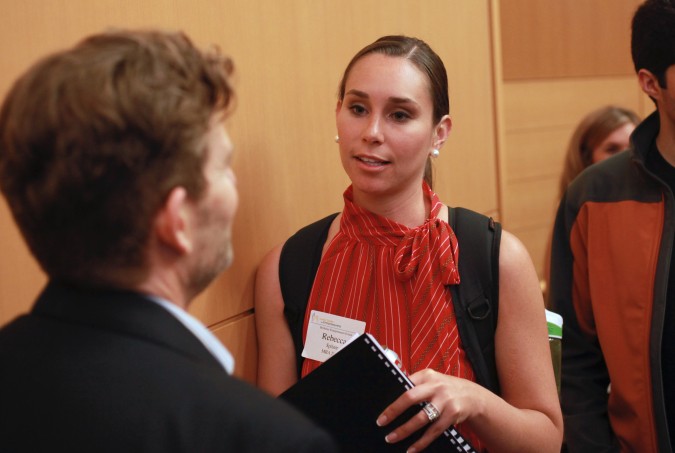
Moderator Sam Angus listens to student Rebecca Spitzer pitch her startup at the Berkeley Entrepreneurs Forum, August 30, 2012
Steve Bengston
PricewaterhouseCoopers
Steve Bengston heads the Emerging Company Services (ECS) group at PricewaterhouseCoopers. ECS acts as “mentor capitalists” for young, high potential companies.
Before joining PwC, Steve had 20 years of experience in a variety of marketing, business development and general management roles at several high tech companies in the Bay Area. Most recently, he was Pres/CEO of ynot.com [Note: not the website now online at that URL], a leading international emarketing and greeting card company. Previously, he was VP Marketing & Business Development at Worldview Systems, an Internet travel pioneer. At Worldview, Steve helped launch and market Travelocity with Sabre Interactive.
Steve has a BA in Economics and MBA from Stanford University. He works closely or sits on the Advisory Board at Churchill Club, SVASE, Life Science Angels, Bay Bio, and the Stanford/MIT Venture Lab, has taught classes on startups at UC Berkeley, San Jose State, Santa Clara Law School, Hastings Law School, and Stanford, and is active in a variety of other organizations in the Bay Area targeting entrepreneurs and investors. He is a frequent moderator/panelist at both university and industry sponsored events.
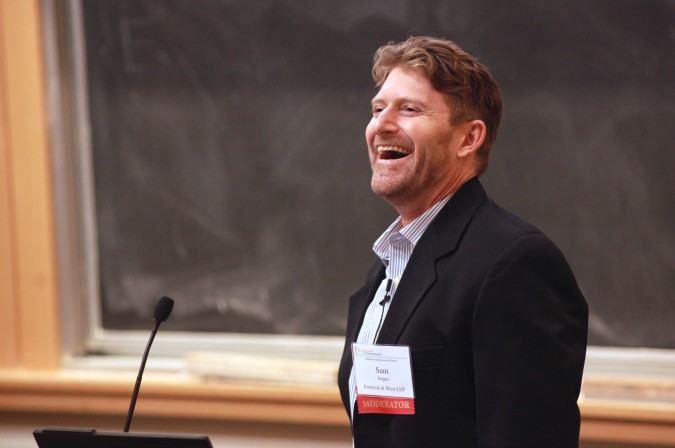
Sam Angus, a partner at law firm Fenwick & West LLP, moderates a panel at the Berkeley Entrepreneurs Forum, August 30, 2012
Jeff Clavier
Founder and Managing Partner
SoftTech VC
Based in Palo Alto, California, Jean-Francois “Jeff” Clavier is the Founder and Managing Partner of SoftTech VC, one of the most active seed stage investors in Web 2.0 startups. Since 2004, Jeff has invested 125 consumer internet startups (Fund I, Fund II, Fund III) in areas like social media, monetization, search, gaming or B2B/B2C web services. These investments are typically located in Silicon Valley, New-York and Boulder. With over 20 years of operational, entrepreneurial and venture capital experience, Jeff is able to add relevant perspective and value to his companies as they grow from inception to maturity, and hopefully, success.
Jeff was recognized as one of the 13 “Web 2.0 King Makers” by (late) Business 2.0. BusinessWeek named him one of “The 25 Most Influential People on the Web” in 2008, and one of the “Top 25 Angels in Tech” in 2010. He was also nominated in the “Best Angel” category at the Crunchies in 2009 and 2010. He is often noted for his investments in categories such as “passion-centric communities” or online gaming, or for having sold a number of his Web 2.0 startups to the likes of Yahoo, AOL, Intuit or more recently PayPal, Twitter and Groupon.
Some of Jeff’s representative investments include Mint (Intuit), Brightroll, Truveo (AOL), Userplane (AOL), Rapleaf, Ustream, Milo (eBay), Blekko, Eventbrite, Tapulous (Disney), DNANexus, FanBridge, BillFloat, Fab, Gigwalk, Byliner and Wildfire.
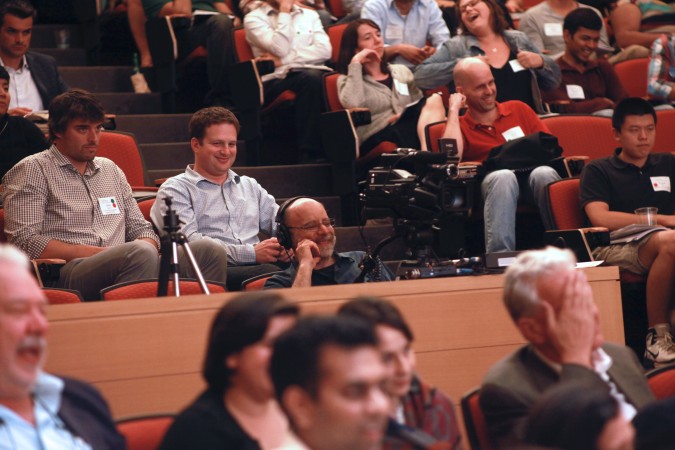
Stuart Sweetow, owner of Audio Video Consultants, capturing video at the Berkeley Entrepreneurs Forum, August 30, 2012
Vivek Mehra
August Capital
Vivek joined August Capital in 2003. He invests broadly in IT infrastructure and areas of interest include data center technologies, systems management, security, storage, and cloud computing systems and software. Prior to joining August Capital, Vivek co-founded Cobalt Networks in 1996. As CTO & VP of Product Development, Vivek built the first successful server appliance and grew Cobalt into a worldwide leader in the category, culminating in a successful IPO and acquisition by Sun Microsystems for $2B. At Sun, Vivek served as the Vice President and General Manager of the Cobalt Business Unit and a member of Sun’s Technical Architecture Council. Prior to founding Cobalt, Vivek held a number of technical and management positions at Apple, SGI, and Digital Equipment Corporation and successfully developed numerous products including Internet enabled set-top boxes, PDAs, RISC workstations, and high performance graphics subsystems.
Vivek received a BS in Electronics from Punjab University, India, and an MS in Computer Engineering from Iowa State University.
To my knowledge, I have been attending The Berkeley Entrepreneurs Forum for longer than anyone else besides Jerry Engel, who founded The Lester Center in 1991 and was its Executive Director for nearly two decades.
I have some suggestions to improve the The Entrepreneurs Forum, which I will describe here. I am posting these suggestions publicly because they are likely applicable to numerous programs across the globe, and I’d like to see these ideas adopted widely if people think they are worthwhile.
1. Dispense with the table panelists sit at. The table doesn’t look good on camera or video, and over time the majority audience for the Forum should be watching online, since the rooms frequently sell out already. Panelists should sit on arm chairs or couches, like they do at most tech conferences that I attend. The moderator should sit with the panelists and not be off to the side standing at a podium. All the people on stage should be outfitted with wireless lapel microphones. I would like the Forum to appear more conversational in style. The table separates the speakers from the audience, where arm chairs suggest a residence for a more intimate vibe.
Here’s an example of a more visually appealing way to run a panel. Steve Bengston is the moderator for this panel at The Churchill Club, where he is a member of its Board of Directors and its past Chair.
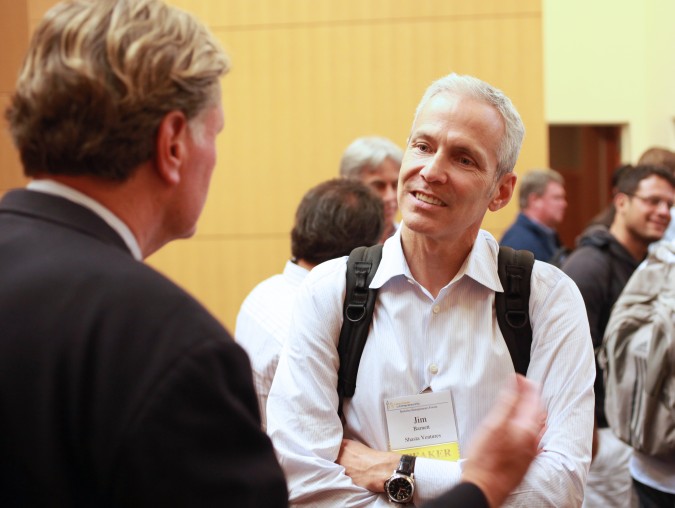
Jeff Burton, the brand new Executive Director of the UC Berkeley Skydeck, talks with Jim Barnett of Shasta Ventures, August 30, 2012
2. Commercial bottled water should be forbidden on stage, even if the speakers bring it with them. Nearly all the conferences I attend serve water from pitchers into real glasses. Bottled water is an evil product, and it looks bad in photographs and video to see those bottles. Image is important, and promoting bottled water by showing it on stage should stop.
3. Commercial bottled water should not be a beverage choice during the networking hour. Tap water should be offered, and it should not require a drink ticket.
4. When it comes time for audience questions, invite the questioner to sit on stage in an arm chair or on the couch while they ask the question and while they are receiving the answer. This will give the questioner time on video, and will permit them to look the speakers in the eye. This will be a treat for the audience members, because they’ll feel they get to ‘meet’ the panelists for 60 or 120 seconds. Questioners can line up to get their turn on stage. Questioners should be encouraged to state their first and last name, so they can be identified online.
5. Although I appreciate that it’s a lot of work, the Forums should be transcribed, and the transcribed text should be posted online. This is a certain way to get more traffic to The Lester Center website, and it’s likely to increase the interest in the Forum from attendees that can’t attend in person.
6. All Forums should be archived online, including Forums from ten and twenty years ago. Forums should never expire and be removed.
7. The ‘numbers’ should be videotaped and included in the online video. The numbers are often the most interesting part of the evening. The contact information for the number presenters should be posted online, with permission of course, and there should be a hyperlink to the project the person is working on.
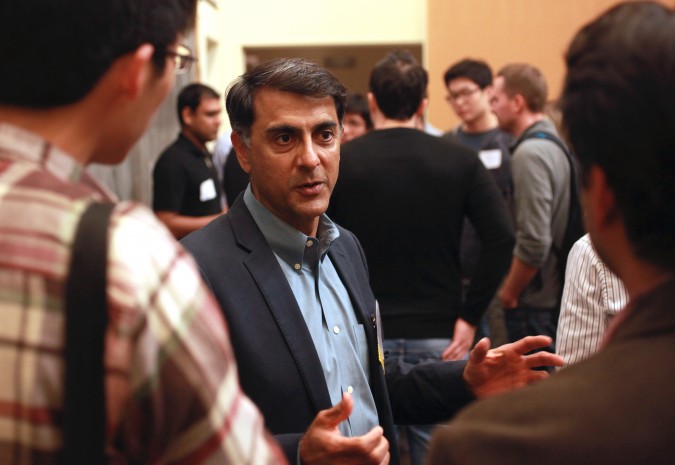
Vivek Mehra, a partner at August Capital, answers questions posed by attendees at the Berkeley Entrepreneurs Forum, August 30, 2012
8. The photographs taken by Bruce Cook, the official photographer, should be publicly posted to Facebook, and should be tagged. Once the identities of the people pictured are known via the tagging, the captions for the official Lester Center website should be updated to identify everyone whose name is known. If required, change the terms of the tickets purchased to give UC Berkeley the right to identify the people by name. Offer an ‘opt out’ list during checkin. Having the names with the pictures will increase traffic to The Lester Center website, since people will search for those names for decades to come. Invite people to tag the pictures in the emails The Lester Center sends out and via Facebook status updates.
9. A vast collection of at least 5,000 of Bruce Cook’s unpublished photographs of the Forum from the last twenty years should be published to Facebook and the Web, and they should be tagged and captioned. This was entirely my idea — Cook did not hint that I propose such an idea. The majority of the pictures published should be of the networking hour, to get as many people from the audiences over the years tagged as possible.
10. The Forum should be oversold, like airplane seats. This August 30th Forum was ‘sold out’ but there were unfilled seats in the auditorium, which takes away from the excitement of a sold out show. If too many people show up, they can watch on video monitors in the Bank of America Forum, and as compensation for not getting a seat, their entrance fee can be 100% refunded. I predict the revenue over time from overbooking will more than make up for the refunds that need to be given. Attendees should be told when they buy their tickets they risk being bumped, and encouraged to arrive early to be sure they get a seat.
11. The reminder to ‘Like’ The Lester Center on Facebook should be repeated on a poster displayed during the Forum. The Forum’s Twitter handle should also be on this poster.
12. Attendees should be given a perk if they follow the Forum on social networks, such as a second drink ticket on their next visit to the Forum, to encourage getting as many followers as possible. Currently attendees may eat unlimited quantities of food at the Forum, but are permitted only one drink, either with alcohol or without.
13. Attendees should be invited to blog and post about the Forums, and The Lester Center site should find and link to the best examples of such efforts, to encourage people to write about the Forum.
I am one of the only bloggers writing about the Forum, but there should be at least several.
14. I love the luxurious food served during the networking hour, but it sure seems like it must cost a fortune. I think it would be more than fine to switch to less fancy food. There is precedent for this. Last year at the Founder School Demo Day what appeared to be inexpensive sandwiches were served, but the event was superb and not diminished by the more everyday food. I suspect the food budget for the Forum could be cut by two thirds without getting more than a handful of complaints. The Forum is still too expensive at USD $25 a ticket, and I bet it loses money even at that price. When I started attending in my mid twenties, the cost was prohibitive. It was only due to my getting free tickets from my employer at the time, Cooley, that I attended regularly. The goal should be to get lots of currently poor entrepreneurs in the making to attend, including but not limited to Berkeley students.
I suggest the price should be no more than $10. To get the price that low, I suggest alcohol should cost extra.
That is all my suggestions for now. The Forum is already a success, or I would not have attended for twenty years. I am trying to make the Forum better.
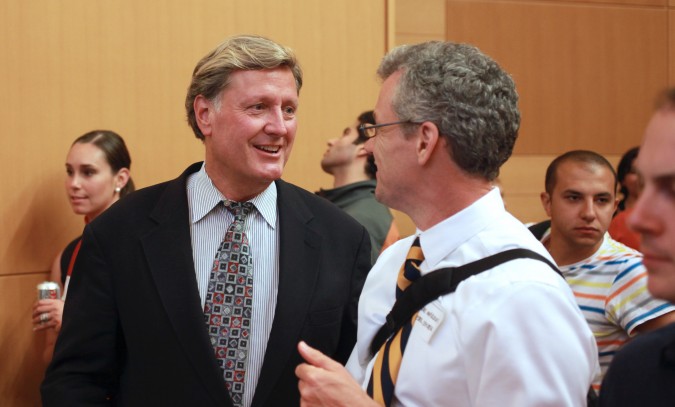
Jeff-Burton, left, the brand new Executive Director of the UC Berkeley Skydeck talks with Andre Marquis, Executive Director of The Lester Center for Entrepreneurship & Innovation, August 30, 2012. Photo by Kevin Warnock.
I upload pictures to this blog at the maximum resolution my camera produces — 21 megapixels. Click on them twice in delayed succession to see them at full size. I shot these pictures at ISO 4,000 due to the low lighting levels.
Click here to see all the posts I have written about the Berkeley Entrepreneurs Forum.
The law firm Fenwick & West LLP where Sam Angus is a partner produced and gave away a great 80 page booklet at the Forum. Retired Fenwick attorney Jacqueline Daunt wrote a fantastic introduction to startups that includes a capitalization table for a hypothetical company from pre-funding stage through a public stock offering. Thank you Fenwick! If I can post this booklet, please let me know and I’ll update this post with a link to a PDF scan of the booklet.
Finally, as an end note, I met Steve Bengston in 1999 during the first dot com boom, when he agreed to help me with Hotpaper, my startup at the time. It turned out I didn’t call on him much, since I lined up financing almost too easily, but I will never forget pitching him at his PriceWaterhouseCoopers office in San Jose, California USA, and him telling me at that meeting that he would help me. Bengston is well known, and I was thrilled to have his support, especially back then when I didn’t know many people or know much of anything.

